There are several ways to change the theme in Windows 11, including the ability to apply the theme from the command prompt. In addition to the classic Personalization option in the Settings app, you can use File Explorer, Command Prompt and PowerShell, the legacy Control Panel, and a few more methods.
Advertisеment
A theme in Windows 11 may include one or several desktop backgrounds, a set of sounds, mouse cursors, desktop icons. The theme also specifies the accent color for apps and window frames.
The user can install new themes from the Microsoft Store or from a locally downloaded file. Such files may have the *.theme, *.themepack, and *.deskthemepack extensions.
A theme file is the classic text file with sections of parameters and their values. All its resources such as wallpapers are usually located in a subdirectory. Themepack and Deskthemepack files are archives (ZIP or CAB) that contain all the theme resources. Microsoft uses these packages since Windows 7 to simplify theme sharing and for their redistribution via the Store.
Windows 11 has themes of the following three types.
- "My themes" - these are themes you have created ("saved") manually, or installed from a *.themepack file or Microsoft Store. Windows saves them in the
%localappdata%\Microsoft\Windows\Themesfolder. - Windows default themes - these are pre-installed themes. You will find them in the
C:\Windows\Resources\Themesfolder. - High Contrast Themes - these themes are part of the Ease of Access feature. They are made specially for people with vision problems. Check out the contents of the
C:\Windows\Resources\Ease of Access Themesfolder.
Change Theme in Windows 11
The easiest method to change the theme in Windows 11 is to right-click the Desktop, and select Personalization from the context menu.
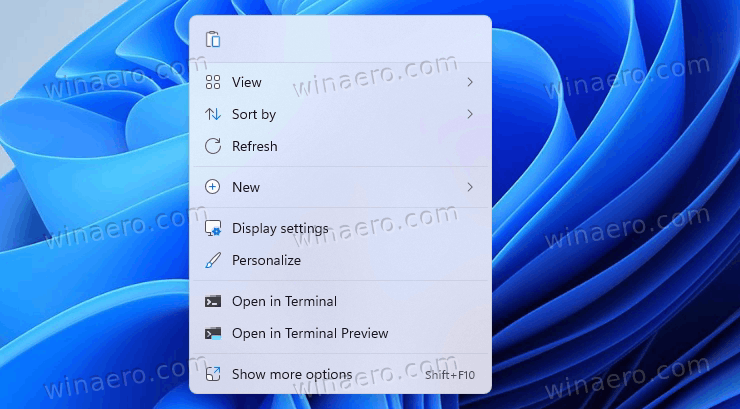
In the next window, simply click the theme you like, and you are done.
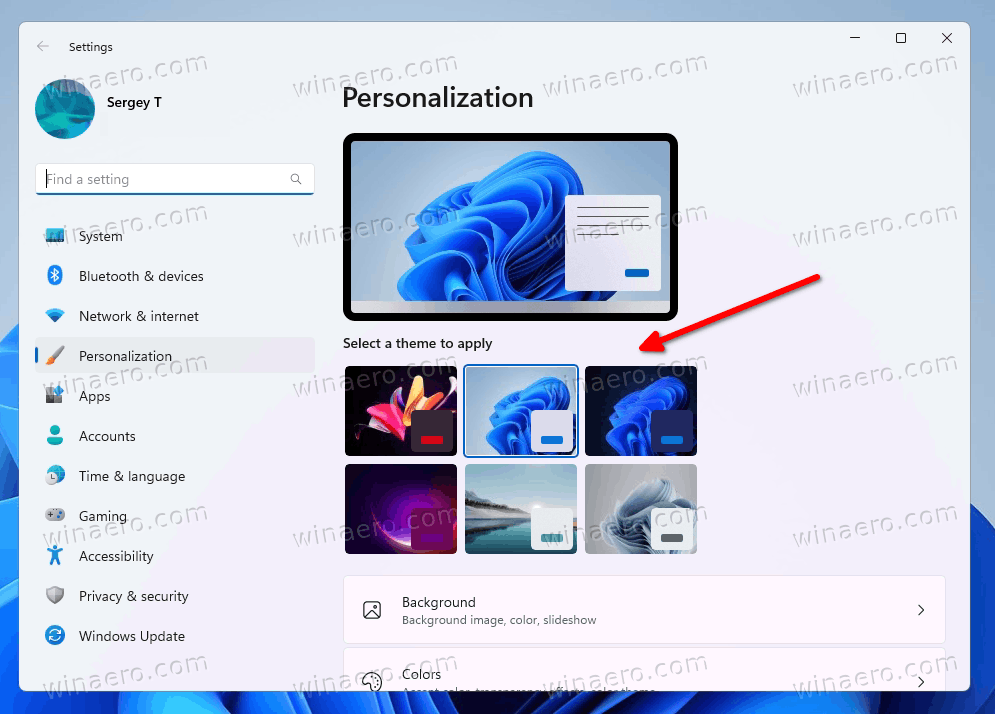
Alternatively, you can use the Settings app, File Explorer, Command Prompt, and even the legacy Control Panel option for the same. Let's review these methods in detail.
Change the Windows 11 theme in Settings
- Open the Settings app by pressing Win + I or using the Start menu shortcut.
- Click Personalization on the left.
- On the right, click on a theme thumbnail preview to directly apply it.
- If you don't see the theme you need, then click on the Themes button below.
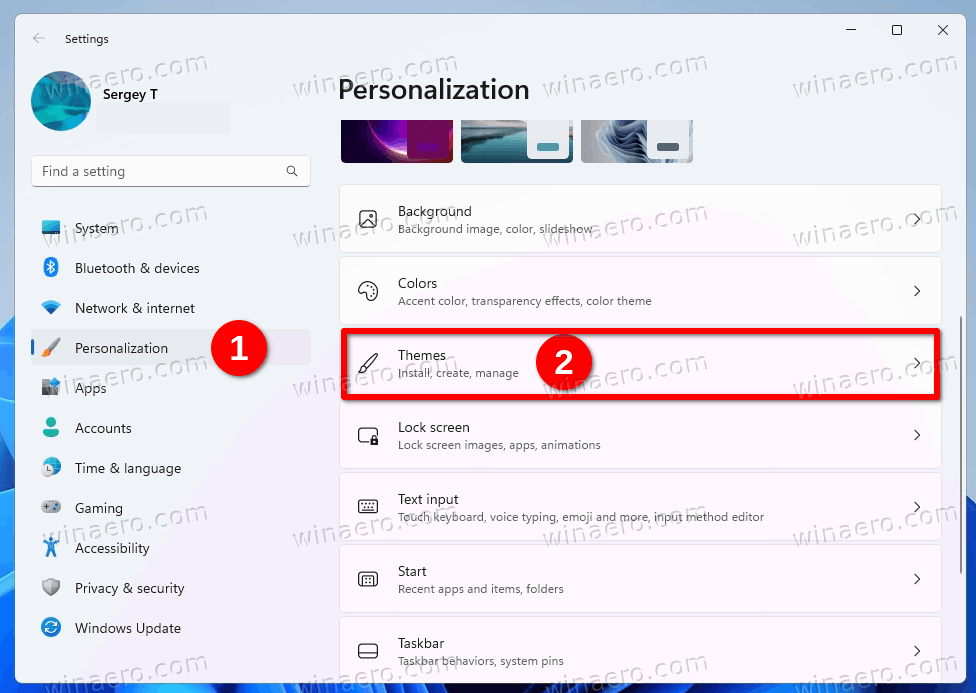
- On the next page, click the theme you like. Windows 11 will change the current one to the selected entry.
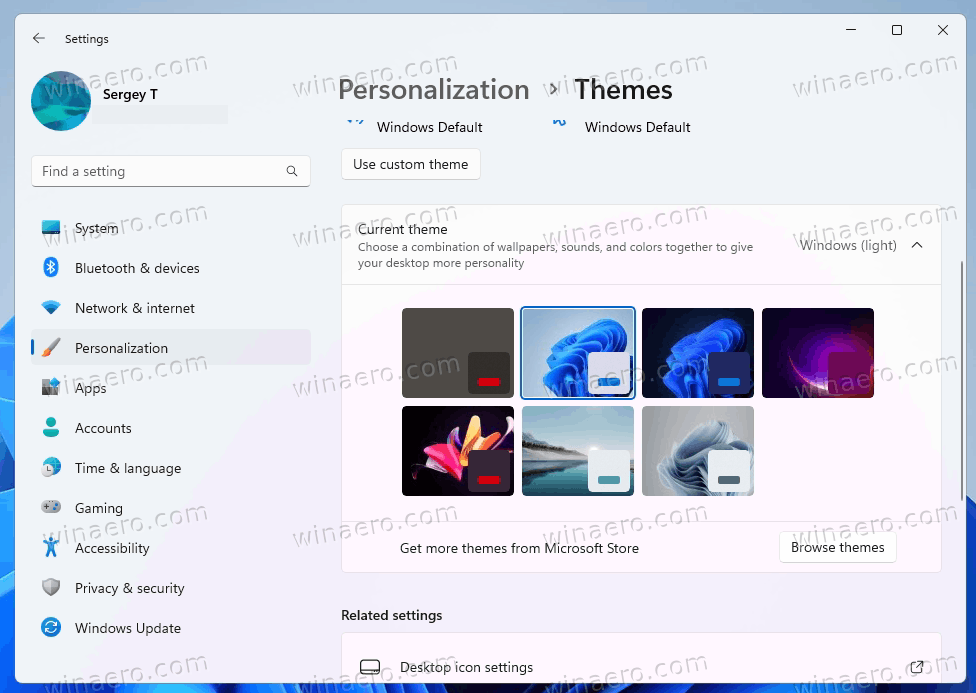
- Finally, you can add more themes from the Store by clicking the Browse themes button.
Done.
On the same page, you can customize the current theme by changing its individual options like background image, cursors, and colors using the buttons below the theme preview box.
Alternatively, you can use the classic "Personalization" dialog. It is still available in Windows 11, but is hidden from the user. You need to use a special command to open it.
Using the legacy Control Panel
- Press Win + R to open the Run box.
- Copy and paste the following command, and hit Enter:
shell:::{ED834ED6-4B5A-4bfe-8F11-A626DCB6A921}.
- Click the desired theme under the My Themes, Windows Default Themes, or High Contrast Themes sections.
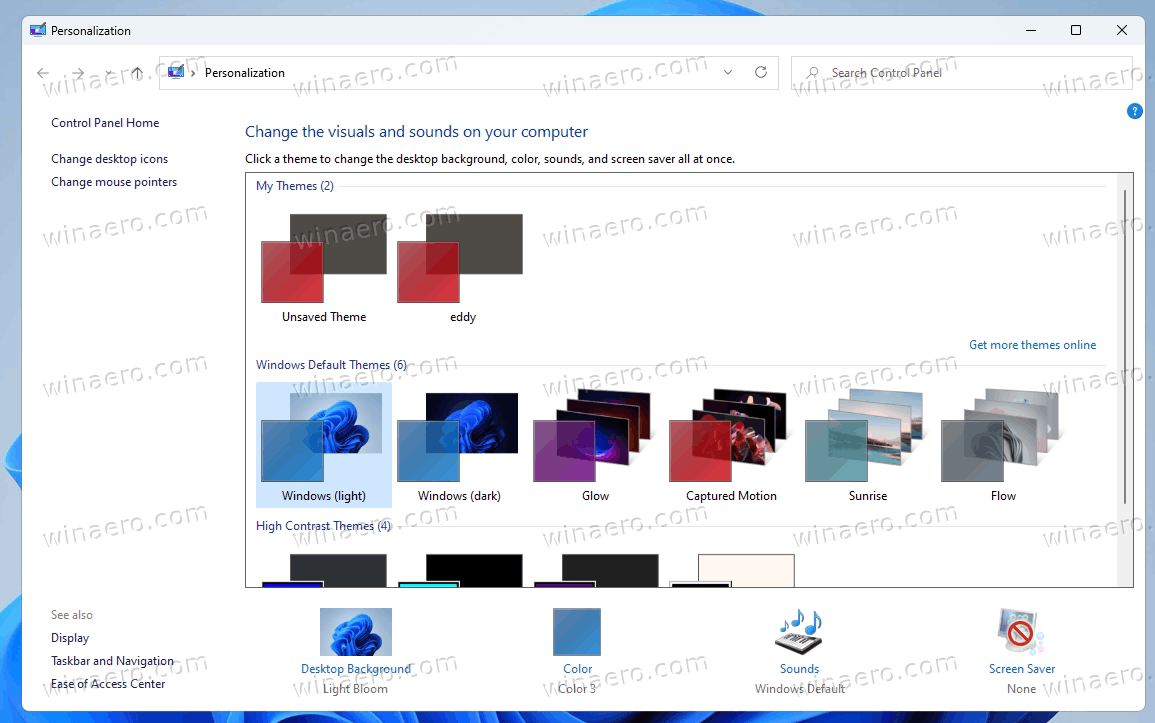
- Once Windows 11 will change the theme, you can close the Control Panel window.
Change the theme from File Explorer
Since all the three theme directories are known, you can open them in File Explorer, and directly click on the *.theme file to apply it. Do the following.
- Open File Explorer by pressing Win + E or by clicking its shortcut in the taskbar or Start.
- Navigate to the folder containing the theme you want to apply, e.g. C:\Windows\Resources\Themes.
- Double-click the *.theme file for the theme you want.
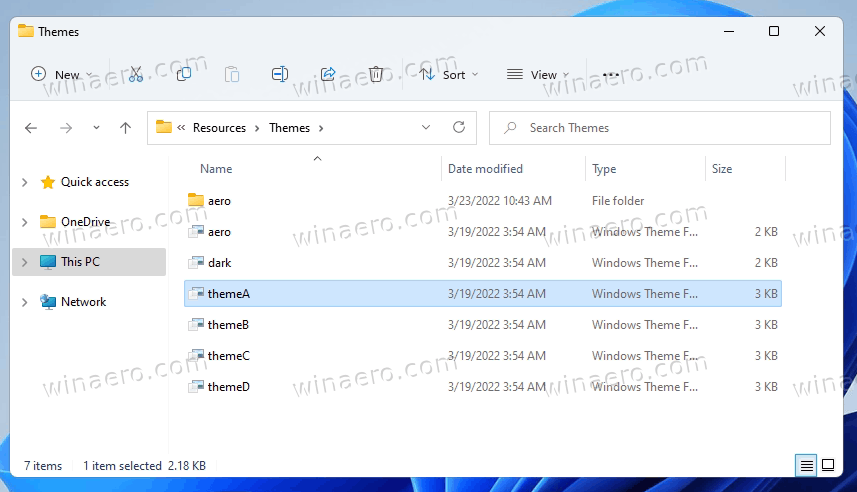
- Close the Settings app that automatically opens once you double-click the theme file.
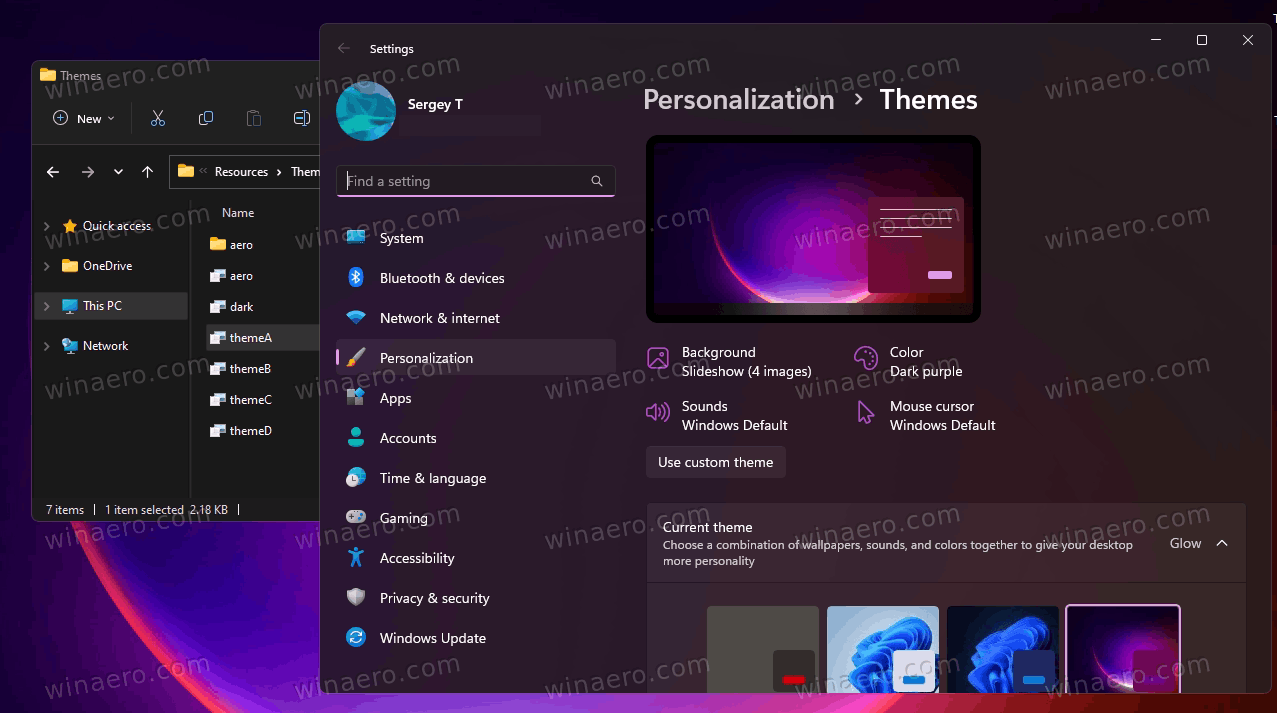
The only downside of this method is that you have to close Settings every time you click the theme file. It opens to the Personalization section.
Change Theme in Windows 11 from Command Prompt
- Open a new command prompt.
- Type
start "" "<full path to the theme file>", and press Enter. For example,start "" "C:\Windows\Resources\Themes\aero.theme".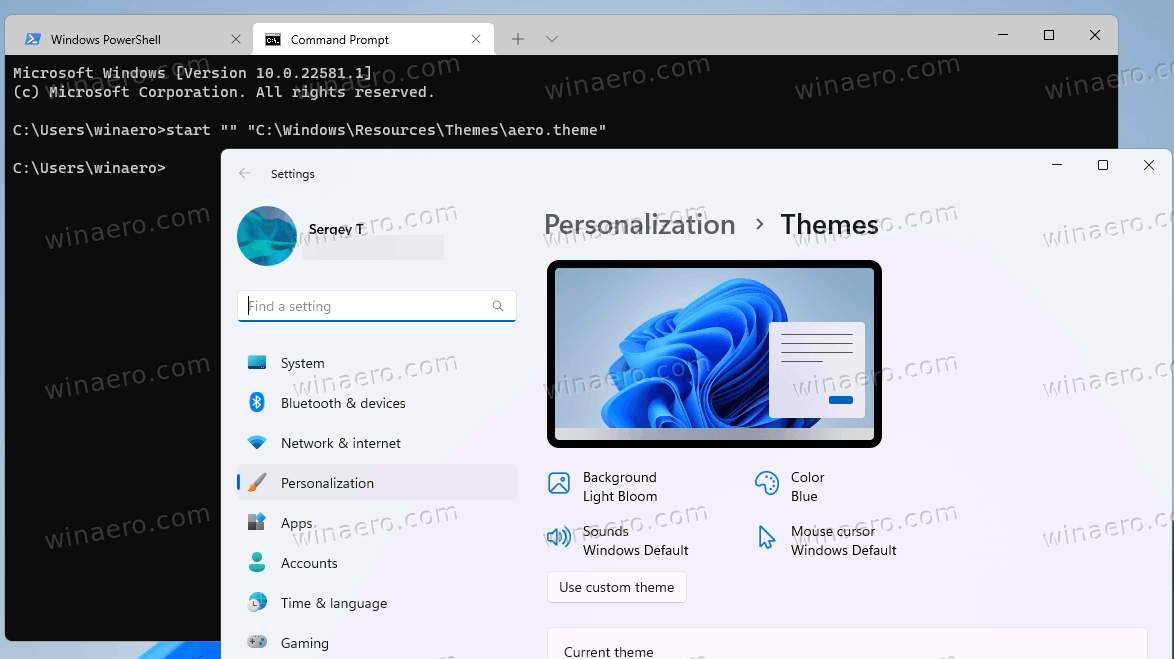
- Windows 11 will apply the theme, and will also open the Settings app.
- Close the Settings app.
If you find it annoying to close the Settings app after changing the theme from the command prompt, modify the command as follows.
start "" "C:\Windows\Resources\Themes\aero.theme" & timeout /t 3 & taskkill /im "systemsettings.exe" /f

It will subsequently apply the theme, wait for 3 seconds with the timeout command, and forcibly close the Settings app with the taskkill app. So the theme will be applied without you having to interact with extra windows. This can be useful for automation scenarios.
Similarly, you can apply a new theme from PowerShell.
Apply a theme from PowerShell
- Open a new PowerShell, e.g. by opening Windows Terminal.
- Type the following command:
start-process -filepath "C:\Windows\Resources\Themes\aero.theme". - Substitute the path to the *.theme file with the actual path for your theme.
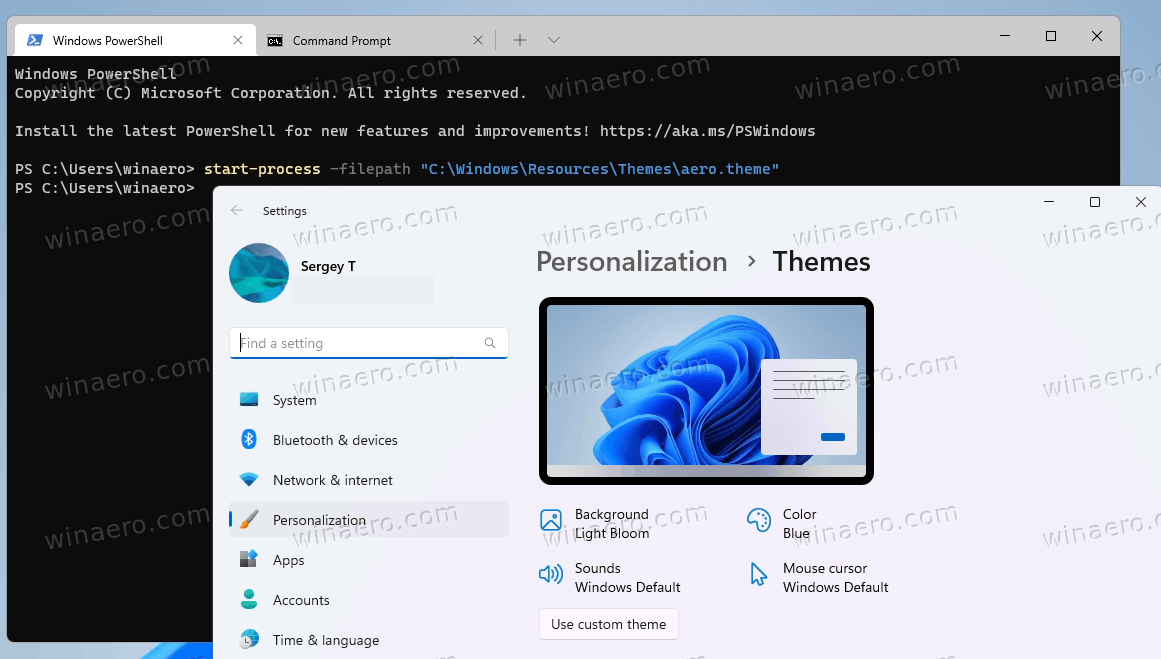
- Windows 11 will change the theme and open the Settings app to the Personalization page.
- To change the theme and automatically close Settings, use the following command
start-process -filepath "C:\Windows\Resources\Themes\aero.theme"; timeout /t 3; taskkill /im "systemsettings.exe" /f.
You are done. The last command calls the tools we have already reviewed in the previous chapter. So only syntax has changed to match PowerShell.
Using Theme Switcher
You can also use the "Theme Switcher" freeware tool that allows applying themes without opening Settings/Personalization. It supports all Windows versions starting with Windows 7.
Download Theme Switcher using this link, and extract the app to any folder. It is a portable tool and doesn't require you to install it.
Run the ThemeSwitcher.exe file. It will show the following dialog.
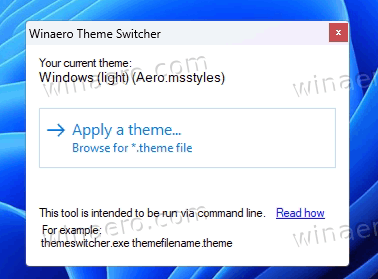
There, you will see what theme is currently in use and what is the msstyles file it uses.
Click the "Apply a theme" button to browse for a theme file and quickly set it as your current theme.
Command line arguments for Theme Switcher
Theme Switcher works best when you specify the theme file as its command line argument. You can run it as follows
Path\to\ThemeSwitcher.exe Path\to\your.theme
Or even as Path\to\ThemeSwitcher.exe your.theme.
In the last example, the app will automatically look for the matching theme file in the known directories mentioned in the previous chapters.
For example, on Windows 11, you can quickly switch between the dark and light themes by using the following commands, respectively:
ThemeSwitcher.exe dark.theme
ThemeSwitcher.exe aero.theme

Finally, you can create a desktop shortcut to themeswitcher.exe and specify the desired theme as its command line argument. Then you will be able to apply it with one click, without opening the Settings app.

Also, by creating a couple of such shortcuts, you can quickly switch between dark and light themes.

The main idea behind the Theme Switcher app is to be a convenient tool for switching between themes with minimal user interaction. It is a good replacement for two console methods reviewed above, as it doesn't require running extra commands to close Settings.
That's it.
Support us
Winaero greatly relies on your support. You can help the site keep bringing you interesting and useful content and software by using these options:
If you like this article, please share it using the buttons below. It won't take a lot from you, but it will help us grow. Thanks for your support!
Advertisеment
